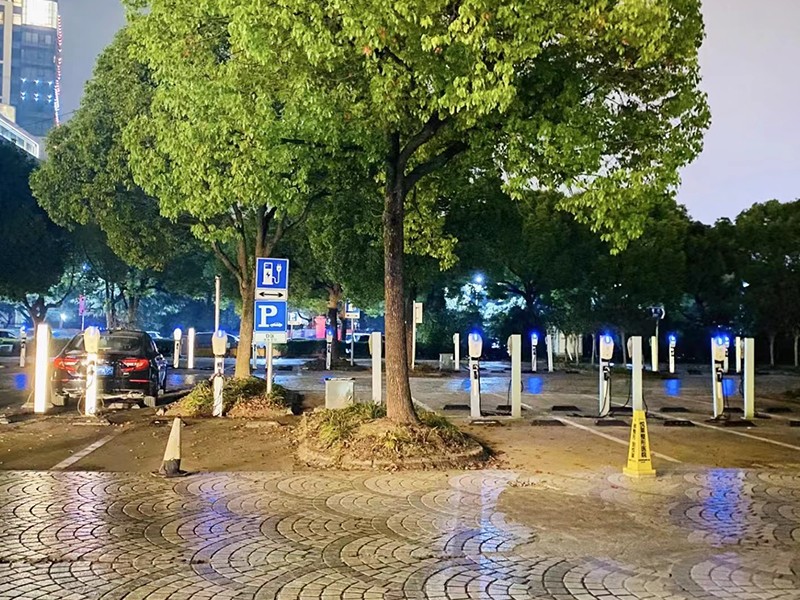High-power Level 2 EV chargers can deliver up to 50 amps (≈12 kW) of charging power, adding roughly 30–40 miles of range per hour. These robust home and commercial chargers (often wall- or pedestal-mounted) support fast overnight or daytime charging for long-range EVs and busy fleets. Many are UL-listed and weather-rated (NEMA 3R/4X) for outdoor use. They typically include 18–25 ft cables, J1772 connectors (with NACS/Tesla adapter options), and smart features like Wi-Fi app control and scheduling.

Why Choose a 50 Amp Level 2 Charger?
A 50 amp Level 2 EV charger (at 240 V) provides around 9–12 kW of power, far exceeding a standard 120 V outlet. In practical terms, this means roughly 30–40 miles of range per hour of charging. For large-battery EVs, daily commuters or work fleets, this faster charging means more uptime. For example, ChargePoint’s Home Flex delivers up to 50 A (12 kW) for ~37 mi/hr, and Autel’s 50 A home charger adds ~48 mi/hr. Higher current is useful if you own multiple EVs, an electric truck/SUV, or have limited hours to charge. Level 2 50 A chargers often include advanced safety (ground-fault/overvoltage protection) and smart energy features, making them suitable for modern homes and business settings.
Key Specs of 50-Amp EV Chargers
-
Power Output: Up to 50 A (≈12 kW at 240 V). (Note: plug-in models on 14‑50 or 6‑50 outlets are often code-limited to ~40 A continuous.)
-
Connectors: Usually SAE J1772 (J-plug) for standard EVs, with optional NACS/Tesla adapter or dual-connector versions. Many units support Tesla vehicles with an adapter.
-
Installation: Hardwired or plug-in (NEMA 14‑50/6‑50). Hardwired models unlock full 50 A output; plug-in units on 50 A outlets typically charge at 40 A (9.6 kW) due to NEC rules.
-
Cable Length: Typically 18–25 ft. Some chargers (e.g. PrimeComTech) offer up to 50 ft cables for flexible parking. Longer cables add convenience but cost more.
-
Smart Features: Most modern units are “smart”: Wi-Fi or Ethernet connectivity, mobile app scheduling, and energy tracking. They may support voice assistants (Alexa, Siri) or integrate with building energy management.
-
Certifications: Look for UL-listed or CE certifications and appropriate Ingress Protection (IP/NEMA) rating. A NEMA 3R/4X (rainproof) or IP54+ rating means safe outdoor use. (E.g. the JSOWELL Level 2 Charger is UL-listed and NEMA 3R for outdoor reliability.)
Top 50-Amp EV Chargers for Home Use
-
JSOWELL Level 2 Charger (50 A): A popular Level 2 home charger that can deliver up to 50 A (hardwired) or 40 A (plug-in). Wi-Fi enabled with an intuitive app and Alexa integration. Delivers up to 37 miles of range per hour. Available with J1772 or NACS (Tesla) connectors. Pros: Well-known brand, robust app and network, ENERGY STAR certified. Cons: Plug-in versions limited to 40 A (hardwire needed for full 50 A); higher cost and installation effort.
-
Autel MaxiCharger AC Lite Home (50 A): A 12 kW charger (50 A) with 25 ft tether and touchscreen. Supports Wi-Fi, Bluetooth, 4G and Alexa/Siri voice control. Adds up to 48 miles/hr. Pros: Advanced smart features (scheduling, energy monitoring, voice assistant), attractive design and colors, lower price (~$455) compared to competitors. Cons: Newer brand (less track record), requires app account.
-
PrimeComTech 50 A EV Charger: A flexible Level 2 unit (240 V) supporting all EVs. Features adjustable output (manually from 12–50 A) and options for 25–50 ft cable lengths. Rugged with IP56 waterproof rating for outdoor use. Includes GFCI protection and scheduling timer. Pros: Manual power setting (maximizes efficiency), very durable (IP56), long cable options. Cons: Basic display (no color touchscreen), limited brand presence.
-
Emporia Level 2 EV Charger (Classic, 48 A): Hardwired unit with 25 ft cable, delivers up to 48 A (11.5 kW) (standard plug version supplies 40 A). Enclosure rated NEMA 4 (waterproof) for indoors/outdoors. Features smart scheduling via free app. Named a “Best EV Charger of 2024,” it offers GFCI safety and remote monitoring. Pros: Award-winning design, built-in Wi-Fi app, robust weatherproof build. Cons: Plug-in config limited to 40 A by outlet, the hardwire model needed for full power.
Top 50-Amp Commercial & Fleet Chargers
-
ChargePoint CPF50 (50 A): A versatile Level 2 station for businesses, fleets, apartments or dealerships. Available with one or two charging ports (supporting simultaneous charging) and 18′ or 23′ cables. Can be wall-mounted or pedestal-installed. UL-listed and ENERGY STAR certified for reliable outdoor use. Supports both J1772 and Tesla (NACS) connectors. It integrates with ChargePoint’s network software for access control, payment and energy management. Pros: Proven platform, dual-port option, commercial-grade durability. Cons: Higher upfront cost and typically requires a service contract.
-
Autel AC Elite Business 50A (12 kW): A commercial-grade 50 A charger with a 5″ touchscreen. It delivers up to 12 kW (50 A) for 48 mi/hr charging. Connectivity includes Wi-Fi, Ethernet, Bluetooth, 4G and even CAN bus for fleet integrations. The unit is CSA/ENERGY STAR certified and built to NEMA 4X (IP66) standards for outdoor exposure, with 25 ft cables. It supports vehicle RFID cards or parking enforcement via software (via Autel’s CSMS platform). Pros: High tech (touchscreen, multiple communications), robust outdoor rating, 3-year warranty. Cons: More expensive ($989), relatively new to market.
-
Dual-Port Pedestal EV Stations: Many workplaces, parking garages or hotels install 50 A dual-port pedestals (often based on models like CPF50 or Autel). These deliver 50 A on each port (12 kW per EV) and include built-in cable management. They are connected to networked charging software (OCPP, etc.) to manage usage and billing. Use case: Ideal for fleet depots or multi-tenant parking, serving two vehicles per unit. Installation requires a large 100 A (or higher) circuit.
-
Other Options: Companies like SemaConnect, Schneider Electric, or EVBox offer Level 2 stations up to 50 A as well. For example, SemaConnect’s commercial stations and Schneider’s EVlink charger can be configured up to 50 A. Tesla’s high-power Wall Connector (48 A/11.5 kW) can serve Tesla fleets (adapters needed for others). Always look for UL/ETL certifications and support for load management (sharing circuit power among chargers).
*Public and workplace chargers (like curbside or hotel stations) let multiple EVs share 50 A outlets. Modern Level 2 pedestals often integrate billing and scheduling. ChargePoint notes that its CPF50 serves apartments, condos, dealerships and hotels, demonstrating how 50 A chargers fit many commercial EV needs. These setups may include payment kiosks or RFID, and must be UL/NEMA rated for outdoor use.
Applications: Home, Fleet & Multi-Unit EV Charging
For residential users, a 50 A charger means full overnight charging even for long-range EVs or electric trucks. Homeowners with multiple EVs or big daily mileage find the speed worth the higher circuit breaker (50 A) and installation cost. In condos or apartment buildings, managed 50 A Level 2 chargers allow each tenant to have high-power charging on demand (often with shared electrical load controls). Workplaces and fleets (delivery vans, service vehicles) use 50 A stations to top off vehicles during day shifts, maximizing utilization. Hospitality and retail (hotels, malls) may offer a few 50 A stations for guests; these are typically commercial-grade with payment kiosks. In each case, the charger’s network connectivity is important for controlling access, tracking usage, and sometimes integrating solar or grid services.

